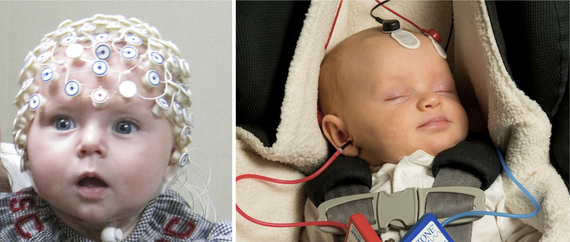Reading is a fundamental ability that is critical for academic success. Currently, 5-15% of school children suffer from reading difficulties, which positions them at a lower starting point in school. Without an appropriate way of detecting these difficulties before they occur, we lack an objective methodology to diagnose reading difficulties. Wouldn't it be great if we could identify neurobiological biomarkers of reading difficulties in less than an hour? Based on recent findings, it looks like we are becoming closer to making this goal a reality.
White-Schwoch and colleagues used electroencephalogram (EEG) recordings to examine potential electrophysiological biomarkers of literacy in preschoolers. EEG is different than functional magnetic resonance imaging because it measures electrophysiological activity of neural responses measured from the surface of the scalp. So, you don't have to lie down in a big magnet, you just have to wear a flexible helmet of electrodes, which is easy for even three-year-old children to do. White-Schwoch and colleagues leveraged the flexibility of EEG measurements to record activity from the surface of the scalp in response to an auditory syllable ('da') presented to 3-14-year-old children. The reason that sounds were chosen in an experiment about reading is that phonological difficulty (e.g. sound processing) is common in people who have reading difficulties.
Differences between a full-array EEG (left) and auditory brainstem response examination (right) in babies (Source for left image can be found here and for the right image, here).
The researchers focused on measuring brain responses from one area (brainstem) since it does not require a full-array of 32 or 64 electrodes and thus, makes it both easier to administer as well as possible to measure in newborn babies. This test also gives information about the inner ear (cochlea) and brain pathways for listening. Surprisingly, an altered brainstem response predicted literacy skills and reading ability one year later in preschool and school-year age children.
These results suggest that this simple 30-minute EEG examination may be used as a potential biomarker for the future occurrence of reading difficulties. This examination may enable accurate and fast diagnoses of children at risk for reading difficulties, even before they actually occur.
Tzipi Horowitz-Kraus is a neuroscientist, as well as member of the Organization for Human Brain Mapping (OHBM) and writes for the Communications/Media Team. The OHBM Media Team brings cutting edge information and research on the human brain to your laptops, desktops and mobile devices in a way that is neurobiologically pleasing. For more information about brain mapping, follow www.humanbrainmapping.org/blog or @OHBMSci_News
Further reading:

